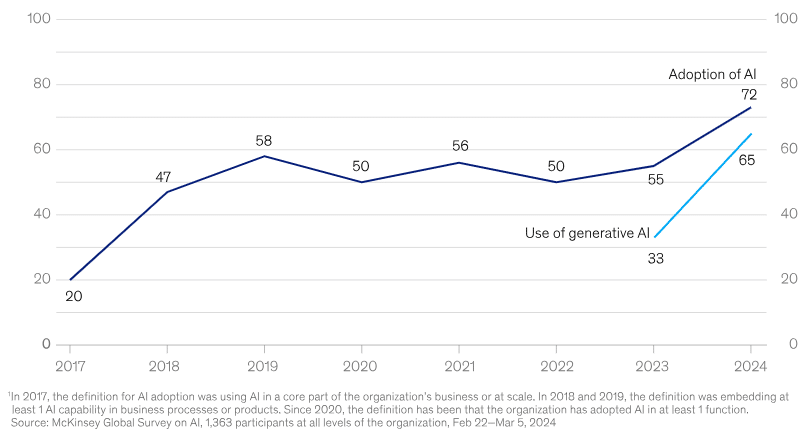
About 65% of organizations now use generative AI, or almost double the number seen in a similar study last year, a McKinsey survey found.

This shift suggests that to remain visible, businesses and content creators must consider how to rank within AI-driven results rather than just traditional search engines.
This article covers what you need to know to gain visibility in generative AI answers such as ChatGPT and Perplexity.
By focusing on key elements that these AI tools prioritize, you can increase the chances that your content is accurately represented and frequently recommended.
GEO: The new SEO for ranking on ChatGPT and Perplexity
Generative engine optimization (GEO) is becoming essential as AI-driven platforms shape how content is ranked and delivered to users.
While traditional SEO principles still matter, optimizing for ChatGPT and Perplexity requires a nuanced approach.
Here are four actionable steps you can take to boost your visibility in generative AI responses.
1. Start with strong SEO fundamentals
If you’re aiming to appear in generative AI results, foundational SEO is still essential.
High-quality, authoritative content is often prioritized by AI tools that rely on structured web data to generate responses.
In other words, if you’re ranking well in traditional search results, you have a head start in ranking for generative AI answers.
Key steps to boost your SEO
- Create high-quality content: Aim to produce well-researched, insightful and unique content that establishes your authority on the topic.
- Enhance technical SEO and use schema markup: Ensure your site’s technical SEO is solid and implement schema markup for better search visibility. Structured data helps AI systems understand the content and context of your pages.
- Focus on entity optimization: Entities are proper nouns like brands, people or locations. Make sure your content is optimized around these key entities, as AI algorithms often prioritize entity-driven content when providing answers.
Maintaining strong SEO practices not only keeps your site ranking well on search engines but also establishes a strong foundation for visibility in generative AI results.
2. Target the right keywords for AI search
When it comes to GEO, choosing the right keywords is critical.
Generative AI platforms respond better to conversational and natural language phrases that closely match user queries.
Think beyond traditional keywords and focus on the type of questions or phrases people might use in AI platforms.
Practical tips for keyword optimization
- Use conversational language: Structure your content around questions and natural language that users might ask, using phrases like “how to,” “tips for” or “best ways to.”
- Focus on long-tail keywords: AI engines often pull information from long-tail keywords that match the specificity of user queries.
- Incorporate natural language processing (NLP) techniques: Write in a conversational tone that aligns with NLP, as generative AI platforms prioritize content that mimics human speech patterns.
Optimizing for AI queries requires a blend of SEO and NLP techniques, allowing your content to match the phrasing and intent of user-generated questions.
3. Analyze competitors in generative AI results
To gain a competitive edge, observe the content that currently ranks well on ChatGPT and Perplexity.
These platforms often prioritize content with a clear structure, strong authority and useful insights.
By assessing competitors’ strategies, you can identify opportunities to tweak your content for better visibility.
Actionable steps for competitor analysis
- Identify top performers: Look for brands or pages frequently referenced in generative AI answers. Note the common themes, content structure and types of questions they answer.
- Analyze content structure and formatting: AI engines favor content that is well-structured with headers, bullet points and short paragraphs. Use these formats to make your content more scannable and accessible.
- Incorporate similar strategies: Once you identify what’s working for competitors, adapt these strategies to your content, whether it’s topic selection, question phrasing or structural layout.
Regularly auditing competitors’ content will give you insights into what resonates with AI algorithms and help you fine-tune your approach.
4. Build a positive brand reputation and encourage reviews
AI models often incorporate user sentiment and brand perception when generating answers.
Brands with positive reviews and strong reputations are more likely to be referenced as reliable sources in generative AI outputs.
Steps to improve brand perception
- Encourage customer reviews: Aim for positive reviews on popular platforms. Reviews signal credibility to AI algorithms and build trust among users.
- Monitor online reputation: Use tools to manage your brand reputation and address any issues that arise promptly. A well-maintained online presence signals reliability.
- Create engaging, trustworthy content: Content that positions your brand as an authority fosters trust, encouraging AI systems to recognize it as a reputable source.
Brand perception can significantly impact how your business is referenced by generative AI models, so make reputation management a core part of your strategy.
Dig deeper: How to build and retain brand trust in the age of AI
Mastering GEO for generative AI visibility
Traditional SEO is now complemented by GEO, aimed at ranking within AI-generated answers on platforms like ChatGPT and Perplexity.
By focusing on foundational SEO practices – like high-quality content, technical SEO and schema markup – you build a solid base for visibility in both search engines and generative AI.
Targeting conversational, natural-language keywords further enhances your chances of matching user queries on AI-driven platforms.
To gain an edge, analyzing competitors who already rank well in AI responses can reveal actionable insights for structuring and enhancing your content.
Lastly, building a positive brand reputation and fostering strong reviews increase the likelihood of your brand being referenced in AI results, where trustworthiness is key.
Following these strategies will position you well in the growing GEO landscape, helping your content achieve relevance in both traditional and AI-driven search results.
source https://searchengineland.com/how-to-gain-visibility-in-generative-ai-answers-geo-for-perplexity-and-chatgpt-448121

0 Comments